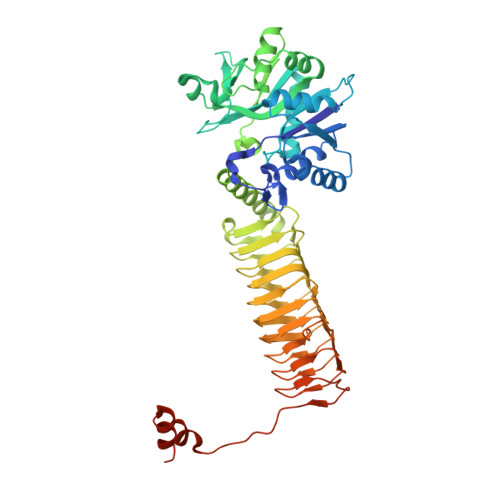The Mechanism of Acetyl Transfer Catalyzed by Mycobacterium tuberculosis GlmU.
Craggs, P.D., Mouilleron, S., Rejzek, M., de Chiara, C., Young, R.J., Field, R.A., Argyrou, A., de Carvalho, L.P.S.(2018) Biochemistry 57: 3387-3401
- PubMed: 29684272
- DOI: https://doi.org/10.1021/acs.biochem.8b00121
- Primary Citation of Related Structures:
6GE9 - PubMed Abstract:
The biosynthetic pathway of peptidoglycan is essential for Mycobacterium tuberculosis. We report here the acetyltransferase substrate specificity and catalytic mechanism of the bifunctional N-acetyltransferase/uridylyltransferase from M. tuberculosis (GlmU). This enzyme is responsible for the final two steps of the synthesis of UDP- N-acetylglucosamine, which is an essential precursor of peptidoglycan, from glucosamine 1-phosphate, acetyl-coenzyme A, and uridine 5'-triphosphate. GlmU utilizes ternary complex formation to transfer an acetyl from acetyl-coenzyme A to glucosamine 1-phosphate to form N-acetylglucosamine 1-phosphate. Steady-state kinetic studies and equilibrium binding experiments indicate that GlmU follows a steady-state ordered kinetic mechanism, with acetyl-coenzyme A binding first, which triggers a conformational change in GlmU, followed by glucosamine 1-phosphate binding. Coenzyme A is the last product to dissociate. Chemistry is partially rate-limiting as indicated by pH-rate studies and solvent kinetic isotope effects. A novel crystal structure of a mimic of the Michaelis complex, with glucose 1-phosphate and acetyl-coenzyme A, helps us to propose the residues involved in deprotonation of glucosamine 1-phosphate and the loop movement that likely generates the active site required for glucosamine 1-phosphate to bind. Together, these results pave the way for the rational discovery of improved inhibitors against M. tuberculosis GlmU, some of which might become candidates for antibiotic discovery programs.
Organizational Affiliation:
Platform Technology and Science , GlaxoSmithKline , Stevenage , U.K.



















